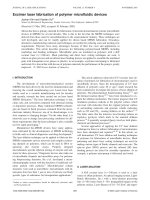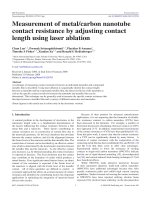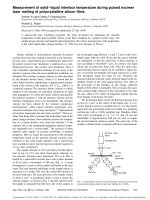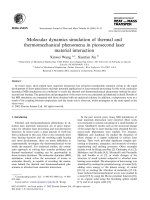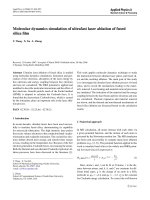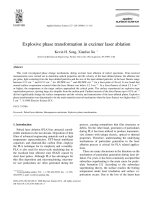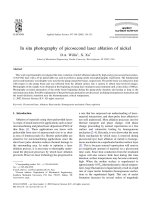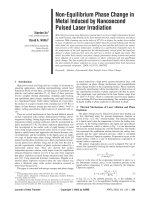explosive phase transformation in excimer laser ablation
Bạn đang xem bản rút gọn của tài liệu. Xem và tải ngay bản đầy đủ của tài liệu tại đây (113.82 KB, 6 trang )
Ž.
Applied Surface Science 127–129 1998 111–116
Explosive phase transformation in excimer laser ablation
Kevin H. Song, Xianfan Xu
)
School of Mechanical Engineering, Purdue UniÕersity, West Lafayette, IN 47907, USA
Abstract
This work investigated phase change mechanisms during excimer laser ablation of nickel specimens. Time-resolved
measurements were carried out to determine optical properties and the velocity of the laser-ablated plume, the ablation rate
per pulse, light scattering from the laser-ablated particles and the size of the laser-ablated particles, in the laser fluence range
y
2 y2
Ž
y
2 y2
.
between 2.5 J cm and 10.5 J cm or 100 MW cm and 400 MW cm for a laser pulse of 26 ns . It was found that
normal surface evaporation occurred when the laser fluence was below 5.2 J cm
y
2
. At a laser fluence of about 5.2 J cm
y
2
or higher, the temperature at the target surface approached the critical point. The surface experienced an explosive-type
vaporization process, ejecting large size droplets from the molten pool. Further increase of the laser fluence up to 9.0 J cm
y
2
did not significantly change the surface temperature and the velocity and transmission of the laser-ablated plume. Explosive
phase transformation was determined to be the main material removal mechanism when the laser fluence was higher than 5.2
Jcm
y
2
. q 1998 Elsevier Science B.V.
PACS: 79.20Ds
Keywords: Pulsed laser ablation; Homogeneous nucleation; Explosive phase transformation
1. Introduction
Ž.
Pulsed laser ablation PLA has attracted consid-
erable attention in the last decade. Deposition of thin
films of advanced engineering materials such as high
temperature superconductors, PZT-based multilayer
capacitors and diamond-like carbon films employs
the PLA technique for its simplicity and versatility.
PLA is also used for micro-scale machining due to
Ž.
the localized heat affected zone HAZ caused by
short laser pulses. Although PLA has advantages for
thin film deposition and micromachining, microme-
ter size particulates are often generated during the
)
Corresponding author. Tel.: q1-765-494-5639; fax: q1-765-
494-0539; e-mail:
process, causing nonuniform thin film structures or
debris. On the other hand, generation of particulates
during PLA has been utilized to produce nanometer-
size clusters with unique electric, optical or thermal
properties. Therefore, understanding the underlying
mechanisms of particulate generation in the laser
ablation process is critical for PLA related applica-
tions.
There are many discussions in the literature on the
mechanism of particulate generation during laser ab-
lation. For years, it has been commonly accepted that
subsurface superheating is the main cause for partic-
wx
ulate formation 1 . According to the subsurface
superheating theory, the surface reaches the boiling
temperature under laser irradiation and surface va-
porization occurs. Due to the loss of the latent heat
0169-4332r98r$19.00 q 1998 Elsevier Science B.V. All rights reserved.
Ž.
PII S0169-4332 97 00619-3
()
K.H. Song, X. XurApplied Surface Science 127–129 1998 111–116112
of vaporization at the surface, the temperature at the
subsurface region is higher than that at the surface.
The pressure beneath the surface is also higher, and
wx
thus explosion takes place. Miotello and Kelly 2
wx
and Kelly and Miotello 3 pointed out that the
maximum temperature difference between the sub-
surface region and the surface was negligible when
appropriate thermal boundary conditions were used,
therefore, the argument of the subsurface superheat-
ing was not valid. Alternatively, they introduced the
explosive vaporization mechanism for the laser abla-
tion process. According to Miotello and Kelly, when
the laser fluence is sufficiently high and the pulse
length is sufficiently short, the temperature of the
specimen could be raised to well above its boiling
Ž
temperature. At a temperature of 0.90TTis the
cc
.
thermodynamic critical temperature , homogeneous
bubble nucleation occurs. The surface undergoes a
rapid transition from superheated liquid to a mixture
of vapor and liquid droplets.
In this work, we carried out experimental studies
on phase change mechanisms during pulsed excimer
laser ablation of nickel specimens. Time-resolved
measurements were performed to determine the ve-
locity and optical properties of the laser-ablated
plume in the laser fluence range from 2.5 J cm
y2
to
10.5 J cm
y2
. Also, the ablation rate per pulse was
estimated by measuring the depth of the ablation
crater. These experimental studies showed that, when
the laser intensity was over 5.2 J cm
y2
, transmissiv-
ity of the laser beam in the laser-ablated plume and
its expansion velocity changed little with laser flu-
ences. Also, when the laser fluence was varied across
the 5.2 J cm
y2
threshold value, there were drastic
increases of ablation depth and scattering of laser
light from the plume. These experimental results
revealed different phase change mechanisms in dif-
ferent laser fluence regimes.
2. Metastable liquid and explosive phase transfor-
mation
To illustrate the heating process of a liquid metal
by a pulsed laser beam, the phase diagram in the
neighborhood of the critical temperature is shown in
wx
Fig. 1 4 . The ‘normal heating’ line indicates the
heating process of a liquid metal when the tempera-
Fig. 1. P–T diagram near the critical point.
ture is below the boiling temperature. At the boiling
temperature, the liquid and the vapor phases are in
equilibrium, which is shown in Fig. 1 as the binode
line calculated from the Clausius–Clapeyron equa-
tion. When the surface temperature of a liquid is
below or at the boiling temperature, evaporation
occurs at the liquid surface, which is a type of
heterogeneous evaporation.
Under rapid heating, it is possible to superheat the
liquid metal to temperatures above the boiling point
wx
5 . The superheating process is represented by the
‘superheating’ line in Fig. 1. However, there is a
well defined upper limit for superheating of a liquid,
Ž.
the spinode Fig. 1 . The spinode is the boundary of
thermodynamic phase stability and is determined by
the second derivatives of the Gibbs’ thermodynamic
wx
potential 6 :
E p ET
s0 and s01
Ž.
ž/ ž/
EV ES
p
T
where V is the specific volume and S is the entropy.
Ž.
Using Eq. 1 , the spinode equation can be derived
from empirical equations of state such as the van der
wx
Waals equation or the Berthelot equation 7 . The
Ž.
derivatives in Eq. 1 are inversely proportional to
wx
fluctuations in liquid 8 :
E pkT
B
sy
2
ž/
EV
T
D
V
Ž.
and
ETkT
3
B
s 2
Ž.
2
ž/
ES
p
D
H
Ž.
()
K.H. Song, X. XurApplied Surface Science 127–129 1998 111–116 113
Fig. 2. Typical variations of physical properties of liquid metal
near the critical point. The substrate ‘o’ denotes properties at the
normal boiling temperature.
where k and H are the Boltzmann constant and
B
enthalpy, respectively. As the temperature ap-
proaches the spinode, the fluctuations DV and D H
Ž. Ž.
increase sharply and E prEV ™ 0, ETrES ™ 0.
Tp
A loss of thermodynamic stability occurs. Intense
fluctuation begins when the temperature of the
metastable liquid approaches 0.8T , which affects
c
physical properties drastically. Fig. 2 shows varia-
tions of properties of liquid metal near the critical
wx
point 9 . The decrease of density is mainly due to
the intensified fluctuation of the specific volume,
DV, and the increase of the specific heat is mainly
due to the increasing fluctuation of enthalpy, D H.
These drastic property changes are called anomalies,
which are also indicated in Fig. 1. Usually, the onset
of anomalies concurrently marks the onset of signifi-
cant reduction or even disappearance of electrical
wx
conductivity of a liquid metal 9,10 . Thus, at the
onset of anomalies, the liquid metal is transferred
from a liquid conductor to a liquid dielectric. Its
transmission to optical radiation increases and sur-
wx
face reflectivity decreases 10 .
Spontaneous nucleation could occur in a
metastable liquid, which affects its stability. Accord-
wx
ing to the Doring and Volmer’s theory 11 , the
¨
frequency of spontaneous nucleation is calculated as:
DG
c
JsNB exp y 3
Ž.
ž/
kT
B
w
3
xwŽ.
2
x
where DG s 16
ps
r 3
r
L
b
is the energy
c00
to form critical vapor nuclei at temperature T, B is a
function whose dependence on temperature and pres-
sure is much less than exponential, N is the number
density of atoms,
s
is surface tension,
r
and L
00
are the density of saturated vapor and latent heat of
vaporization at the normal boiling temperature T ,
0
and
b
is the degree of superheating, defined as
Ž. Ž.
b
s Ty T rT . According to Eq. 3 , the sponta-
00
neous nucleation rate increases exponentially with
temperature. It has been shown that the frequency of
spontaneous nucleation is about 0.1 s
y1
cm
y3
at the
temperature near 0.89 T , but increases to 10
21
s
y1
c
y3
wx
cm at 0.91T 2 . This indicates that a rapidly
c
heated liquid could possess considerable stability
with respect to spontaneous nucleation up to 0.89T ,
c
with an avalanche-like onset of spontaneous nucle-
ation of the entire high temperature liquid layer at
about 0.91T . Therefore, at a temperature of about
c
0.9T , homogeneous nucleation, or explosive phase
c
transformation occurs.
During pulsed excimer laser heating, radiation
energy from the laser beam is transformed to thermal
energy within the radiation penetration depth, which
is about 10 nm for Ni at the KrF excimer laser
wavelength. Superheating is possible since the ex-
cimer laser pulse is short, on the order of 10
y8
s.
Within this time duration, the amount of nuclei
generated by spontaneous nucleation is small at tem-
peratures below 0.9T , thus the liquid can be heated
c
to the metastable state. Depending on the laser flu-
ence, the target surface can be melted, and the liquid
can successively undergo the normal heating process,
the superheating process and the explosive phase
change. Heterogeneous evaporation always occurs at
the liquid surface, however, when the laser intensity
is strong enough to induce explosive phase transfor-
mation, physical phenomena associated with laser
ablation are dominated by explosive vaporization.
3. Experimental study
3.1. Descriptions of the experiments
Experiments are carried out to investigate the
excimer laser ablation process. A KrF excimer laser
with a wavelength of 248 nm and a pulse width of
Ž.
26 ns full width at half maximum, FWHM is used.
The laser fluence is varied from 2.5 J cm
y2
to 10.5 J
cm
y2
. A 99.94% pure nickel specimen is used as the
()
K.H. Song, X. XurApplied Surface Science 127–129 1998 111–116114
ablation target. Experimental procedures and appara-
tus are described in details in other publications
wx
12,13 . Only a brief description of each experiment
is given here.
The optical deflection technique is employed to
measure the velocity of the laser-ablated plume. In
this experiment, a probing HeNe laser beam travel-
ing parallel to the target surface passes through the
laser-ablated plume. The intensity of the probing
beam is disturbed due to discontinuity of optical
properties across the laser-induced shock wave, and
due to scattering and absorption by the plume. The
distance between the probing beam and the target
surface is incrementally adjusted and the correspond-
ing arrival time of the probing beam fluctuation is
recorded. The velocity of the laser-ablated plume can
be obtained from the distance–time relation.
Optical properties of the laser-ablated plume are
measured. Transmission of the plume at the excimer
laser wavelength is measured by a probing beam
separated from the excimer laser beam. This probing
beam passes through the plume and a small hole
Ž.
diameter ;10
m
m fabricated on the specimen,
which is a free-standing nickel foil with a thickness
of about 6
m
m. The small hole and the thin foil
target ensure detection of transmission when the
plume thickness is only a few micrometers. Scatter-
ing of the laser beam from the plume is measured at
different angles. Based on the radiative transfer anal-
ysis, the measured angular scattering intensity distri-
bution is used to determine the size of the scattering
center in the plume. The total laser energy loss to the
ambient due to scattering from the plume and reflec-
tion from the target surface is also measured. The
laser energy distribution are determined from these
measurement results.
The averaged ablation rate per pulse is estimated
by measuring the depth of the laser ablation crater
accumulated over 960 pulses, using scanning elec-
tron microscopy.
3.2. Experimental results and discussion
Results of the measured expansion velocity of the
laser-ablated plume, transmissivity of the laser-
ablated plume, the percentage of laser energy scat-
tered from the plume, and the ablation rate per pulse
are shown in Figs. 3–5, respectively. According to
Fig. 3. Velocity of the plume front.
these results, the laser fluence range used in the
experiment can be divided into three regions: the low
fluence region with laser fluences between 2.5 J
cm
y2
and 5.2 J cm
y2
, the medium fluence region
with laser fluences between 5.2 J cm
y2
and 9.0 J
cm
y2
, and the high fluence region with laser flu-
ences higher than 9.0 J cm
y2
.
Fig. 3 shows variations of the plume velocity with
the laser fluence. These are averaged velocity values
within the laser pulse width. The experiment showed
that the velocity of the plume front decayed slightly
Ž.
; 10% within the laser pulse width. The time-aver-
aged velocity increases with the laser fluence in-
crease, from ; 2000 m s
y1
at the lowest fluence to
; 8000 m s
y1
at the highest fluence. However, the
increase of velocity is not monotonous; the velocity
is almost a constant in the medium fluence region.
The velocity of the plume is determined by the
pressure and the temperature at the target surface.
The constant velocity in the medium fluence region
indicates that the surface temperature is not affected
by the increase of the laser fluence in the medium
fluence region. Such a constant surface temperature
can be explained as a result of explosive evaporation.
As discussed earlier, the maximum surface tempera-
ture during explosive phase transformation is about
0.9T , the spinodal temperature. Once the laser flu-
c
ence is high enough to raise the surface temperature
to the spinode, further increase of the laser fluence
would not raise the surface temperature. On the other
hand, in the low fluence region, the velocity in-
creases over 50%. Therefore, the surface temperature
increases with the laser fluence increase; heteroge-
neous vaporization occurs at the surface. At the
()
K.H. Song, X. XurApplied Surface Science 127–129 1998 111–116 115
Fig. 4. Transient transmissivity of the laser beam through the
laser-ablated plume.
highest laser fluence, the velocity of the plume is
higher than that of the middle region. This could be
due to a higher absorption rate of the laser energy by
the plume, as shown in the transmission measure-
Ž.
ment Fig. 4 . Absorption of laser energy by the
plume further raises the temperature of the plume
and increases the plume velocity.
Fig. 4 shows transient transmissivity of the plume
at the excimer laser wavelength. The transmissivity
remains at ‘1’ for the first several nanoseconds,
which is the time duration before evaporation occurs.
Transmissivity starts to decrease at an earlier time at
higher laser fluences since evaporation occurs earlier
at higher fluences. Transmission of the laser beam
decreases with the increase of the laser fluence;
however, it does not change with the laser fluence in
the medium fluence region, i.e., extinction of the
laser beam in the plume does not vary with the laser
intensity in the medium fluence region. Extinction of
the laser beam is determined by the cross-section of
the energized atoms, which in turn is determined by
the temperature of the plume. As discussed earlier,
temperatures of the evaporant in the medium fluence
range are all about 0.9T , thus, transmission of the
c
plume stays at a constant value. At the highest laser
fluence, transmissivity decreases from that of the
middle fluence range, indicating the increase of ab-
sorption of laser light by the plume.
Fig. 5 shows the percentage of laser energy scat-
tered from the plume. The size of the scattering
center in the plume was measured to be about 120
wx
nm by Xu and Song 12 , therefore, scattering is
mainly due to large size liquid droplets. Fig. 5 shows
Ž
that there is almost no scattering less than 0.5%, the
.
measurement resolution in the low laser fluence
region. Therefore, there is almost no large size liquid
droplets in the plume. When the laser fluence is
higher than 5.2 J cm
y2
, the percentage of laser
energy scattered by the plume is about 4 to 6%,
indicating the existence of liquid droplets in the
plume. When explosive phase change occurs, the
entire surface layer with a temperature near 0.9T is
c
evaporated from the target. The high recoil pressure
caused by explosive vaporization flushes out liquid
from the molten pool. The evaporant during explo-
sive evaporation is thus a mixture of atomic vapor
and liquid droplets. Therefore, the result of the scat-
tering measurement provides a direct indication of
the transition from heterogeneous evaporation to ex-
plosive phase transformation at the laser fluence
around 5.2 J cm
y2
.
Fig. 5 also shows the averaged ablation rate per
laser pulse. A substantial increase of the ablation rate
occurs at the laser fluence of 5.2 J cm
y2
; the abla-
tion rate per pulse jumps from about 20 nm at 4.2 J
cm
y2
to about 63 nm at 5.2 J cm
y2
. This can be
viewed as another evidence of the transition from
heterogeneous evaporation to explosive evaporation
at the laser fluence of 5.2 J cm
y2
, since the ablation
rate increases during explosive evaporation due to
Ž.
ejection of liquid droplets . Fig. 5 also shows that,
when the laser fluence is higher than 5.2 J cm
y2
, the
ablation rate increases slightly with the laser fluence.
One reason for this is the increase of melt depth with
the laser fluence, therefore, more liquid is expelled
from the molten pool during explosive evaporation.
Also, as shown in Fig. 2, anomalies of physical
properties occur at temperatures higher than 0.8T ,
c
Fig. 5. Percentage of laser energy scattered from the laser-ablated
plume and the ablation rate per laser pulse.
()
K.H. Song, X. XurApplied Surface Science 127–129 1998 111–116116
the liquid metal becomes less conductive, behaving
more like a dielectric material. Therefore, laser radia-
tion could penetrate deeper into the material, extend-
ing the optical absorption depth. This effect could
further increase the melt depth at higher laser flu-
ences.
4. Conclusions
Mechanisms of PLA at different laser fluence
regions were examined experimentally. Time-re-
solved measurements were performed to determine
the velocity of the laser-induced plume, transmission
and scattering of the laser beam from the plume and
the ablation rate per pulse, at the laser fluences
between 2.5 J cm
y2
and 10.5 J cm
y2
. The experi-
mental results showed that, when the laser fluence
was between 5.2 J cm
y2
and 9.0 J cm
y2
, transmis-
sivity of the laser beam in the laser-ablated plume
and its expansion velocity changed little. Further,
there were drastic variations of the ablation depth
and scattering of laser light when the laser fluence
was varied across 5.2 J cm
y2
. All the experimental
results consistently showed laser ablation was due to
heterogeneous evaporation when the laser fluence
was below 5.2 J cm
y2
, and explosive phase change
dominated the evaporation process when the laser
fluence was higher than the 5.2 J cm
y2
threshold
value.
Acknowledgements
Support by the National Science Foundation un-
der grant number CTS-9624890 is gratefully ac-
knowledged.
References
wx Ž.
1 F.P. Gagliano, U.C. Paek, Appl. Opt. 13 1974 274.
wx Ž.
2 A. Miotello, R. Kelly, Appl. Phys. Lett. 67 1995 3535.
wx Ž.
3 R. Kelly, A. Miotello, Appl. Surf. Sci. 96–98 1996 205.
wx Ž.
4 M.M. Martynyuk, Russ. J. Phys. Chem. 57 1983 494.
wx Ž.
5 W. Fucke, U. Seydel, High Temp. High Press. 12 1980
419.
wx Ž.
6 M.M. Martynyuk, Fiz. Gorenniya i Vzryva 13 1977 213.
wx
7 C. Domb, The Critical Point, Taylor and Francis, 1996.
wx Ž.
8 M.M. Martynyuk, Sov. Phys. Tech. Phys. 19 1974 793.
wx Ž.
9 M.M. Martynyuk, Russ. J. Phys. Chem. 49 1975 1545.
wx
10 V.A. Bantanov, F.V. Bunkin, A.M. Prokhorov, V.B. Fe-
Ž.
dorov, Sov. Phys. JETP 36 1973 311.
wx
11 V.P. Skripov, Metastable Liquids, Wiley, New York, 1974.
wx Ž.
12 X. Xu, K.H. Song, J. Heat Transfer 119 1997 502.
wx Ž.
13 K.H. Song, X. Xu, Appl. Phys. A 65 1997 477.
